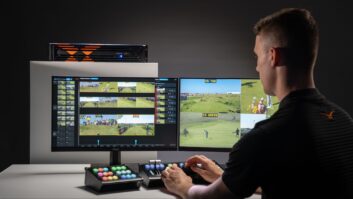A group of research scientists has invented a device that eliminates some of the potentially eye-warping effects of 3DTV displays. With a patent pending and currently only in laboratory form, the device has received interest from leading consumer electronics companies. The system (pictured) is designed to combat ‘vergence-accommodation conflict’ an effect that afflicts certain viewers of 3D and causes eye-discomfort and headaches. “Without appropriate vergence, you would see double, and without appropriate accommodation, your vision is blurred,” explained Martin Banks, a professor of the Visual Space Perception Laboratory at the University of California, Berkeley. Vergence describes how the eyes rotate so that an image is always in the centre of both retinas. Accommodation is the focus response by the lens inside each eye. “Vergence and accommodation are essentially always trained to the same distance in real life, but on a stereo 3D display that relationship is broken,” explained Banks. “Because viewers must focus at one distance (where light is emitting from the screen) but verge at another distance (wherever the 3D object appears to be in space).” This difference in distance when viewing 3D may be the source of headaches and other discomforts. With Gordon Love, a reader in physics at Durham University, Banks has built a device which he claims can counter this. The device employs lens in front of each eye to focus the images for the viewer to resolve the discrepancy. There is a software element also, but Banks isn’t revealing the secret sauce because of the pending patent. “The first version was a basic research instrument and never practical to market because it was too big and complicated and requires very careful alignment,” he said. “We have patented a slimmed down version which we are talking to the industry about and which seems much pretty feasible.” He adds: “Because the user’s position is known in the setup, the device can optically correct the focus accurately. In tests on volunteers, users reported significantly fewer symptoms related to eye tiredness, vision clarity, and headaches than when not using the device to view 3D images.”
The vergence-accommodation conflict may be worse on the small screen. “As you go farther away from the screen, the consequences of the conflict are going to be less,” says Banks. “I’m not worried about the cinema situation because the distance is long.” Banks says that the discomfort is not felt by everyone and that he is not sure what it is about some people that make them more susceptible than others. “The only thing we are convinced of is that age matters. The older you are, the less susceptible you are to vergence accommodation conflict. The most important thing is to understand the effect and to manage it.” Banks was a speaker at last month’s SMPTE 3D conference in NYC where he delivered a paper outlining how the effects of presentation rate, speed of motion and simultaneity of image delivery to the eyes create flickering, jerky and depth distortions. “The reason is not because of stereo per se but because of the need to switch back and forth between left and right eyes under current display systems,” he said. “By switching to dark frames alternately, each eye is seeing brightness and then darkness then brightness again. I will make recommendations for minimizing flicker, motion artifacts, and depth distortions.”
Fellow researchers investigating stereoscopy and the human visual system and speaking at SMPTE will explore where the biological, physiological and images sciences meet. Banks receives most of his funding from US federal government agencies concerned with public health issues. “If we were funded by the 3D industry our research would prove problematic,” he added. “What if we found negative issues regarding certain displays? If we are funded by government we are under no obligation to take our research in a certain direction – we can tell the truth.” www.smpte.org
Scientists crack eye-strain conundrum
A group of research scientists has invented a device that eliminates some of the potentially eye-warping effects of 3DTV displays. With a patent pending and currently only in laboratory form, the device has received interest from leading consumer electronics companies.







